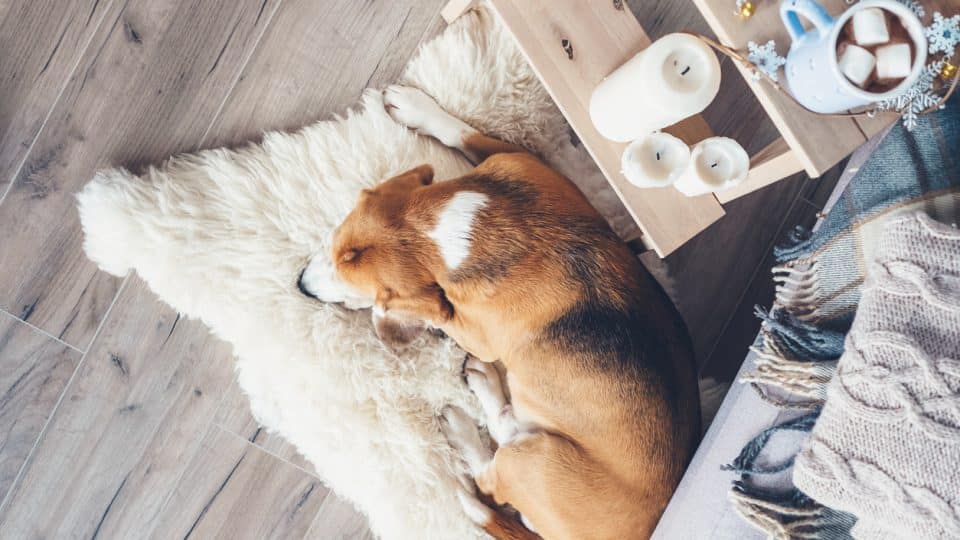We light candles for plenty of reasons, from creating ambience in a room (hello, cosy winter nights!) to birthdays and religious celebrations.
However, while we humans might be aware of the safety precautions associated with these little flames, our dogs are less conscious of their hazards and may even be curious about the flickering flame and interesting scents. So does this mean candles are bad for dogs?
Simply put, there isn’t a clear-cut answer on candle safety for dogs. While dog owners shouldn’t feel prohibited from lighting candles altogether, paying extra attention to the candle type and taking extra precautions when using them is essential. After all, nobody wants to harm their pet inadvertently!
Read on to discover the best ways to use candles around your dog.
Candle Safety Tips For Dog Pet Parents
Trust us: you’re not alone in pausing before lighting a candle and wondering if it’s safe to do so with a dog around.
Supervising your pet when candles are lit is always a good idea, as you don’t want any accidental knocks or burns. But it’s not only the flame or heat aspect of candles to consider. Some waxes contain harmful or irritating chemicals, while flames and scents can irritate a dog’s nose.
So what should you be mindful of? Here are some elements to consider before striking that match.
Choose the right candle
Candles made using natural wax ingredients—such as beeswax, soy, and vegetables—may be a better bet for your dog.
This is for two reasons. The first is that some types of wax can be dangerous to dogs if ingested—and we know some dogs will chew on anything they can get their paws on.
“Many candles contain synthetic chemicals that could cause digestive upset or even neurotoxic effects,” reveals Nell Ostermeier, DVM, CVA, FAAVA, integrative veterinarian and spokesperson for AKC Pet Insurance. “Like any other foreign object that a dog chooses to ingest, wax can cause gastrointestinal issues and even blockage.” As such, keeping candles out of your dog’s reach is important, lit or otherwise.
Another key consideration is that some synthetic waxes are thought to emit chemicals and toxins into the air when burned. As such, “it is better to go with candles that don’t contain carcinogenic toxins such as paraffin, lead, benzene, and acetaldehyde,” Ostermeier says.

Image credit: Marta Klos | iStock
Canines are generally more susceptible to nasal irritation since they have far more sensitive noses. “Dogs have a more sensitive sense of smell than humans,” explains Ostermeier. Phoenix Vet Centre reveals that a canine’s nose has around 300 million smell receptors, compared to six million in a human.
Because of this heightened sense of smell, you should also be wary of burning scented candles around your pooch. An attractive smell to an owner might be overwhelming for a dog—or even encourage them to mistake it for food!
Finally, go for a candle with a pure cotton wick. Wicks with lead cores have not been available in the UK since the 1970s due to safety concerns and rarely pop up elsewhere due to bans in other countries, including the US. But it’s always worth double-checking when it comes to imports. Not only is cotton less harmful if a dog ingests it, but it’s also not going to release lead fumes into the air when burned.
Pick the proper place to burn it
Wagging tails and excited leaps are always welcome—unless there’s an open flame around. Ostermeier explains that burns are one of the most common candle-related issues in dogs. So keep candles on higher shelves, and don’t leave your dog alone in a room with lit wicks.
In addition, burning your candle in a large and well-ventilated room will enable the fumes to disperse and prevent irritation to your dog’s sensitive nasal receptors.
Buy candles specifically for pet aromatherapy
Aromatherapy—using essential oils from plants to enhance well-being—is a practice that humans have looked to for centuries. But aromatherapy can be helpful for dogs, too.
Plenty of candles on the market have a specific pooch-pleasing design, even though they’re equally alluring to humans. Even better? Their scents (which often include aromas such as vanilla, lavender, and musk) also help to neutralise any unpleasant pet-related smells in the home. An all-around win!
Here are a few of our favourite dog-friendly and pet-odour-eliminating candles:
- Be:Pure Pet Odour Eliminating Candle, £20.38
- Wild. For Dogs Winter Walkies Pet-Friendly Candle, £19.00
- Day of the Dogs Candle, £18.99

Image credit: Liliboas | iStock
Be mindful of essential oils
Some candle brands use essential oils to create the scents in their products, as they smell delicious to us humans. However, according to the Pet Poison Helpline in the US, some oils can cause skin irritation, hind leg paralysis, vomiting, and hypothermia in dogs. These essential oils can even contribute to nervous system damage and can cause liver damage or renal issues if ingested.
As Ostermeier notes, “You cannot control the dose of essential oil that is emitted from a candle.” Even a few drops can be enough to cause problems.
Particular oils are more harmful than others if inhaled or ingested by our canine pals or come into contact with their skin. According to Ostermeier, ones to be avoided include:
- Birch
- Tea tree
- Wintergreen
- Cinnamon
- Citrus
- Peppermint
- Pine
- Sweet birch
- Ylang ylang
If you’re unsure about using a particular oil, check with your vet before introducing it into the home.
Ingredients To Look Out For In Candles
Here’s a quick recap of some of the key ingredients for dog owners to avoid when choosing a candle:
- Paraffin. This is common material used to create wax. Research suggests that, when burned, paraffin releases toxins such as toluene, formaldehyde, acrolein, benzene, and acetaldehyde into the air.
- Lead. Some metal-based wicks contain this material. However, its fumes not only create indoor air pollution but have also been linked to affecting the central nervous system.
- Certain scents/essential oils. Oils such as tea tree, birch, and wintergreen can cause skin, nose, and throat irritation and liver and nervous system issues. “It is good to be cautious when using any essential oils around your dog,” states Ostermeier.
When It’s Important To Steer Away From Candles
It’s never a good idea for some pooches to be around candles, even if they contain dog-friendly ingredients.
“If your dog has a respiratory condition, such as seasonal allergies, bronchitis or asthma, burning scented candles in the home may make it worse,” explains Ostermeier. If your dog begins wheezing or symptoms related to its condition worsen, contact your vet straight away.
It’s also worth being mindful of candle use if your dog has a history of epilepsy or seizures. “In very rare instances, in dogs who suffer from epilepsy or seizure disorders, scents from candles/diffusers may have links to possibly inducing seizures,” Ostermeier notes. If your dog has a seizure disorder but you’d like to use scents of some kind to liven up a room, “your best course of action is to have a conversation with your primary vet,” she continues. They’ll be able to advise on which scents/essential oils to avoid or whether you should avoid them altogether.

Image credit: Vera Tereshchenkova | iStock
What Are Some Safe Alternatives To Candles?
If you’re uncertain about burning candles in your home, there are alternatives to help clear odours and introduce fresh scents into a space. (But please be aware that incense is not one of them, as burning this can lead to indoor air pollution and respiratory irritation.)
- Air purifier. Rather than covering certain smells with new ones, purifiers filter and deodorise air for clean breathing.
Dyson Purifier Hot+Cool™ Autoreact, £599.99 - Charcoal air purifier. A charcoal purifier is another air filtering and deodorising option. It uses activated charcoal to absorb nasty smells and toxins in the air.
CLEVAST Bamboo Charcoal Air Purifying Bags, £19.99 - Ultrasonic diffuser. These gadgets use water to disperse appealing scents via minuscule vapour droplets. While the aromas come from essential oils, “diffusers are much safer than candles as you can control the ‘dose’,” says Ostermeier. “The safe dose for most oils is just two to three drops in the diffuser.” Remember to always avoid oils that are toxic to dogs, no matter how little you’re using.
ASAKUKI 300ml Essential Oil Diffuser, £24.99 - Air freshener/room spray. Room sprays spritz scented liquid into the air that evaporates as it disperses, so it’s better for a quick fix than a permanent odour cover-up.
All Natural Pet Room Freshener Spray, £6.95 - Potpourri. Typically made by mixing dried flower with essential oils, and, when left out in a bowl, their scent gently disseminates around a room. Watch out though: the oil content in potpourri means they can be highly toxic to dogs—so always keep well out of reach (and ensure it comprises pooch-friendly oils).
Qinbei Rina Blue Pot Potpourri, £14.99

Image credit: PrathanChorruangsak | iStock
What To Do If Your Dog Ingests A Candle
Left unsupervised, your dog might be tempted to take a bite (or several) from a candle. In this instance, “you should immediately call your primary care vet or an emergency veterinary facility in your area. They will help you decide what the next best step is for your dog,” states Ostermeier.
If you know what ingredients are in your candle, “you can also go to the Pet Poison Control website, which allows you to search toxins and their effects on pets,” she adds.
What To Do If Your Dog Gets A Burn
Has you dog knocked over a hot candle? Once you’re sure the flame is out, check your canine’s fur and skin thoroughly. Whether a bit of wax has caught your dog’s fur or they’ve sustained a burn to the skin determines the best course of action to take. (However, if there’s wax or burns on the pads of their paws, follow this guidance.)
For wax:
- Don’t try to remove the wax while it’s still hot and soft.
- Instead, run cold water over or submerge the affected area, keeping your dog there for five minutes. You might find this is easiest in the shower or bathtub.
- Only when the wax has hardened and cooled should you attempt to remove it by clipping off any hair covered with wax. If you don’t have much experience trimming dog fur or it’s a particularly tricky spot, don’t be afraid to “schedule a grooming or veterinary appointment to get the job done safely,” says Ostermeier.
- If you’re unsure whether the wax has caused a burn, check in with your vet to be safe.
For burns:
- “Treat immediately by running cool water over the area, gently wiping with a cool wet washcloth, or submerging the affected area in cool (not iced!) water,” Ostermeier shares.
- Even though you might do so when treating a human burn, don’t add saline or salt to the water.
- Your dog may require prescription medication to help with pain or to prevent infection, so Ostermeier states you should contact your vet as a matter of urgency.
Takeaway
As we’ve established, there’s no straightforward answer to whether candles are safe for dogs. While some candles are suitable for burning around our furry pals, there are important factors to consider, such as wax ingredients, scents and oils, and ventilation.
Safety is a priority for dogs of all ages—not just when they’re young. Fire is a particular hazard in the home, with over 8,000 incidents caused by candles each year. If you want to keep your canine safe in other situations, you can also check out our articles on car safety and walking at night.



